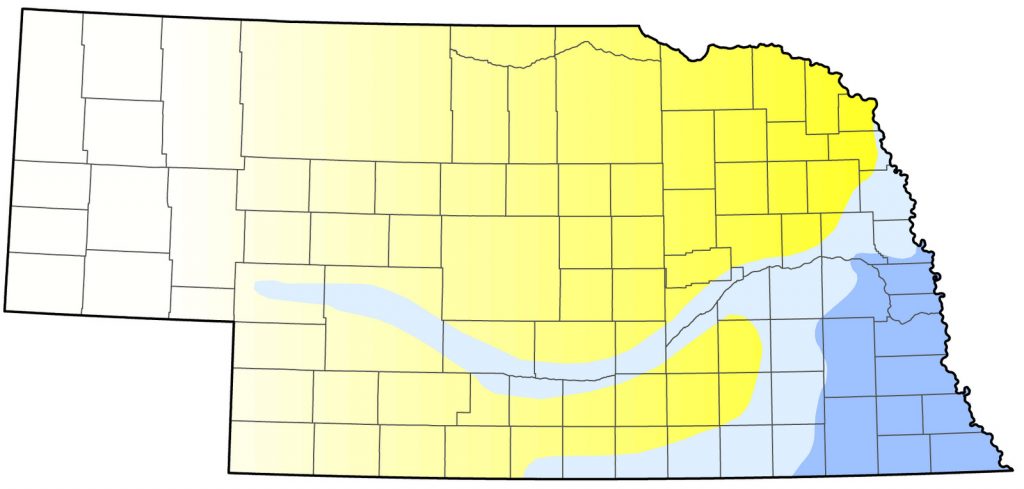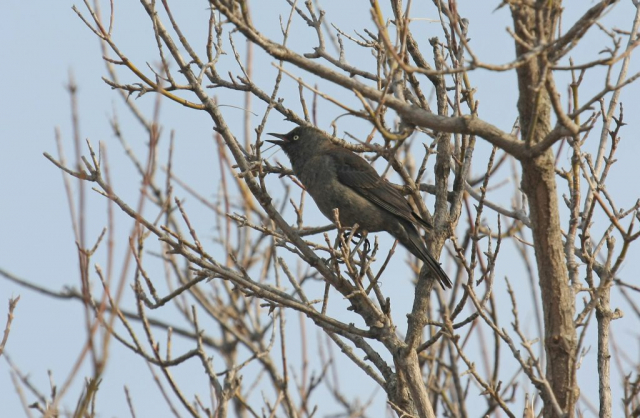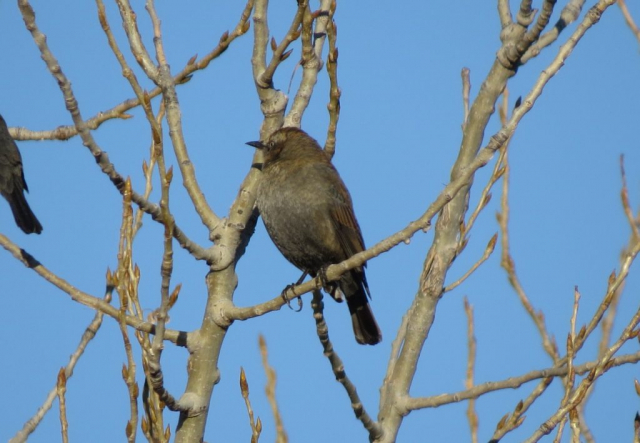Euphagus carolinus carolinus
Status: Uncommon regular spring migrant east, rare central, rare casual west. Uncommon regular fall migrant east and central, rare west. Uncommon regular winter visitor east and south, rare north, rare casual west.

Documentation: Specimen: UNSM ZM9568, 31 Oct 1919 Niobrara Valley Preserve, Cherry Co.
Taxonomy: Two subspecies are recognized (Avery 2020, AviList 2025): nigrans, breeding in Newfoundland, Nova Scotia, and the Magdalene Islands, wintering south to Georgia, and carolinus, breeding across Alaska and Canada, wintering from southeast Alaska and southern British Columbia east to Ontario and south (generally east of the Great Plains) to east Texas and Florida.
Nebraska birds are presumed carolinus.
Spring: winter <<<>>> Apr 20, 21, 22 (east); Feb 26, 26, 26 <<<>>> Apr 3, 4, 4 (central)
A later date in the east was 17 May 2025 Thurston Co.
Early dates above for central are for north of the Platte River Valley.
Later dates in the central are 9 Apr 2025 Lincoln Co, and 16 Apr 2013 Valley Co.
Because of wintering birds, the beginning of migration is difficult to discern in the east, but probably begins in late Feb, as suggested by a count of 500 in Washington Co 24 Feb 1983 (Williams 1983). Evidence of spring movement away from the east suggests that migration begins in late Feb-mid Mar; 39 were at Brewster, Blaine Co 26 Feb 2016, a group of up to 20 wintering in Custer Co from 4 Jan 2013 departed 12 Mar, 30 were in Lincoln Co 4 Mar 2020, 10 dwindling to one were in Lincoln Co 16 Mar-1 Apr 2021, and there are dates in the west-central of five on 6 Mar 2006 Keith Co, 13 Mar 2010 Custer Co, and 14 Mar 2005 and 20 Mar 2021 in Lincoln Co. Peak migration probably occurs in Mar and departure is completed by mid-Apr.
In the Panhandle, Rusty Blackbird is less than annual in spring; there are several undocumented reports, and only these with details: 1-2 at Clear Creek WMA, Garden Co 27-28 Mar 1999, and one at Oliver Reservoir, Kimball Co 13 Apr 2019.
Rusty Blackbird has been declining throughout its range for decades including the central plains (Greenberg and Matsouka 2010). Bruner et al (1904) considered it a common migrant. In Kansas, Thompson et al (2011) stated Rusty Blackbird was “once common during migration and during the winter … but has become irregular with reduced numbers”. Avery (2020) noted an “alarming decline” of 85-95% during the period 1970-2010.
The many published reports without details, some in May and later, no doubt result from confusion with Common Grackle or Brewer’s Blackbird (see Comments). The latest specimen date for spring in Kansas is 17 Apr, and there are no Kansas sight records later than 1 May (Thompson et al 2011).
- High counts: 100 at Sinninger Lagoon WPA, York Co 16 Apr 1995, 40-70 at Pawnee Lake, Lancaster Co 3-8 Mar 2023, 63 at George D. Syas WMA, Platte Co 1 Apr 2022, and 60 at Stagecoach SRA, Lancaster Co 5 Mar 2023.
Fall: Oct 10, 10, 11 <<<>>> winter
Earlier dates are 15 Sep 1933 Lincoln Co (Tout 1947), 19-21 Sep 1988 Cedar Co, 22 Sep 2012 Wayne Co, 4 Oct 2012 Douglas Co, 4 Oct 2021 Deuel Co, and 5 Oct 2020 two locations Knox Co.
Migrants are more widespread in fall than in spring. Arrival is in mid-Oct. Peak fall migration probably occurs in late Oct and Nov.
This species is rare in the Panhandle; Rosche (1982) called it “very rare”, with sightings 28 Sep-21 Nov, and Rosche and Johnsgard (1984) cited fall dates at Lewellen, Garden Co 14 Oct-7 Nov. Additional Panhandle dates are of singles at Lake Minatare, Scotts Bluff 10 Oct 2020, Chappell Lake, Deuel Co 4 Oct 2021, and at Oliver Reservoir, Kimball Co 26 Oct 2020, a videotape of a female at Little Lake Alice, Scotts Bluff Co 25 Oct 2014, 30 Oct 2024 Scotts Bluff Co, a specimen, UNSM ZM7023, taken at Chadron, Dawes Co 3 Nov 1919, two in Scotts Bluff Co 5 Nov 2021, six in Lewellen 6 Nov 2012, one in Deuel Co 18 Nov 2005, and one at Oliver Reservoir, Kimball Co 29 Nov 2021. Two were in Scotts Bluff Co 30 Nov 2022. For later dates, see Winter.
Rusty Blackbirds are fairly numerous in the east in Dec; CBC data show counts of 99 and 25 as far north as Beaver Valley, Boone Co in 1986 and 1985 respectively, and 156 as far west as Grand Island, Hall Co in 1990. Highest CBC counts are 626 at Omaha in 1984-1985 and 357 there in 1971-1972; since 1990, however, CBC numbers appear to have declined, with highest annual totals 200 in 1988-1989 and 147 in 2015-2016.
- High counts: 150-200 at Fontenelle Forest 5 Nov 2009, 111 at Branched Oak Lake, Lancaster Co 21 Nov 2014, 95 at Pawnee Lake SRA, Lancaster Co 5 Nov 2021, and 88 near Niobrara, Knox Co 25 Oct 2006.
Winter: This species winters regularly in the southern parts of the state, with most in the east, but occasionally further north, especially in the Missouri River Valley, where there are early Feb reports in Pierce and Dakota Cos. A group of 1-4 wintered at Ike’s Lake, Wayne Co 14 Jan-23 Feb 2022.
Away from the east and south winter range, there are these reports for the north in Jan-Feb: 1 Jan 2005 Burwell, Garfield Co, 4 Jan 1951 and 6 Jan 1955 Antelope Co, 4 Jan 2020 Holt Co, 7 Jan 1988, 10 Jan 1981, 11 Jan 1986 Boone Co, 12 Jan 2025 Wheeler Co, 16 Jan 1952 Antelope Co, up to 20 (on 24 Jan) were noted at Broken Bow SL, Custer Co 4 Jan 2012-12 Mar 2013, one on 28 Jan 2011 in Custer Co, and three on 13 Feb 2018 in Loup Co. It wintered for some years in Holt Co (Blake and Ducey 1991).
The only west report in midwinter (Jan) away from the North Platte River Valley is 21 Jan 1974 Crawford, Dawes Co. Rosche (1982) considered Rusty Blackbird a casual winter visitor in the northwest, and Rosche (1994) noted that few survive or remain after 20 Jan in the Keith Co area.
Good counts in the east are of 200 wintering in Sarpy Co 1984-85 (Williams 1985), 94 at Olive Creek Reservoir, Lancaster Co 26 Feb 2023, 92 on the DeSoto NWR CBC 27 Dec 2009, and 84 in Jefferson Co 10 Feb 2023.
Comments: Rusty Blackbird may be associated with more misidentifications than other blackbirds occurring in Nebraska. A specimen, UNSM ZM10595, collected at Crawford 12 Sep 1911 and labeled as this species is in fact a Brewer’s Blackbird. Rosche (1982) noted that a Rusty Blackbird specimen in the collection at Chadron State College was mislabeled as an immature Brown-headed Cowbird.
There are numerous undocumented reports for the period May-Aug, including one putative record of breeding in Hall Co in 1972 (Ducey 1988) which is disregarded (Johnsgard 1979, Mollhoff 2022). There are five recoveries of birds identified as Rusty Blackbirds which were banded in Arkansas and recovered in Nebraska in May and Jun: 9 May 1934 Antelope Co, 29 May 1932 Madison Co, Jun 1940 Antelope Co, 10 Jun 1931 Saunders Co, and 12 Jun 1931 Fillmore Co. Discussion with Danny Bystrak of the Bird Banding Laboratory (Dec 2016) suggested that the dates of these recoveries were most likely incorrect and were more likely the dates the recovered bands were reported to the Bird Banding Laboratory.
Images
Abbreviations
CBC: Christmas Bird Count
NWR: National Wildlife Refuge
SHP: State Historical Park
SL: Sewage Lagoons
SRA: State Recreation Area
UNSM: University of Nebraska State Museum
WMA: Wildlife Management Area (State)
WPA: Waterfowl Production Area (Federal)
Literature Cited
Avery, M.L. 2020. Rusty Blackbird (Euphagus carolinus), version 1.0. In Birds of the World (A. F. Poole, Editor). Cornell Lab of Ornithology, Ithaca, NY, USA. https://doi.org/10.2173/bow.rusbla.01.
AviList Core Team, 2025. AviList: The Global Avian Checklist, v2025. https://doi.org/10.2173/avilist.v2025.
Blake, L., and J. E. Ducey. 1991. Birds of the eastern Sandhills in Holt County, Nebraska. NBR 59: 103-132.
Bruner, L., R.H. Wolcott, and M.H. Swenk. 1904. A preliminary review of the birds of Nebraska, with synopses. Klopp and Bartlett, Omaha, Nebraska, USA.
Ducey, J.E. 1988. Nebraska birds, breeding status and distribution. Simmons-Boardman Books, Omaha, Nebraska, USA.
Greenberg, R., and S.M. Matsuoka. 2010. Special Section: Range-wide Ecology of the Declining Rusty Blackbird: Mysteries of a Species in Decline. The Condor 112: 770-777.
Johnsgard, P.A. 1979. Birds of the Great Plains: breeding species and their distribution. University of Nebraska Press, Lincoln, Nebraska, USA.
Mollhoff, W.J. 2022. Nest records of Nebraska birds. Nebraska Ornithologists’ Union Occasional Paper Number 9.
Rosche, R.C. 1982. Birds of northwestern Nebraska and southwestern South Dakota, an annotated checklist. Cottonwood Press, Crawford, Nebraska, USA.
Rosche, R.C. 1994. Birds of the Lake McConaughy area and the North Platte River valley, Nebraska. Published by the author, Chadron, Nebraska, USA.
Rosche, R.C., and P.A. Johnsgard. 1984. Birds of Lake McConaughy and the North Platte River Valley, Oshkosh to Keystone. NBR 52: 26-35.
Thompson, M.C., C.A. Ely, B. Gress, C. Otte, S.T. Patti, D. Seibel, and E.A. Young. 2011. Birds of Kansas. University Press of Kansas, Lawrence, Kansas, USA.
Tout, W. 1947. Lincoln County birds. Published by the author, North Platte, Nebraska, USA.
Williams, F. 1983. Southern Great Plains Region. American Birds 37: 314-317.
Williams, F. 1985. Southern Great Plains Region. American Birds 39: 182-185.
Recommended Citation
Silcock, W.R., and J.G. Jorgensen. 2025. Rusty Blackbird (Euphagus carolinus). In Birds of Nebraska — Online. www.BirdsofNebraska.org
Birds of Nebraska – Online
Updated 23 Jul 2025


